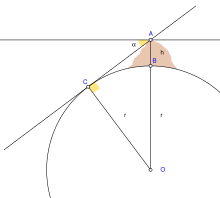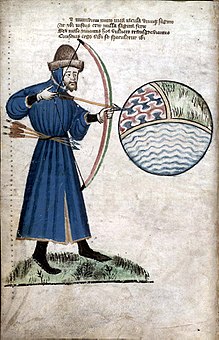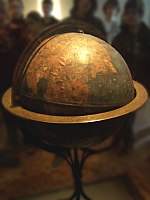Spherical Earth

The concept of a spherical Earth dates back to around the 6th century BC, when it was mentioned in ancient Greek philosophy,[1][2] but remained a matter of philosophical speculation until the 3rd century BC, when Hellenistic astronomy established the spherical shape of the Earth as a physical given. The paradigm was gradually adopted throughout the Old World during Late Antiquity and the Middle Ages.[3][4][5][6] A practical demonstration of Earth's sphericity was achieved by Ferdinand Magellan and Juan Sebastián Elcano's expedition's circumnavigation (1519−1522).[7]
The concept of a spherical Earth displaced earlier beliefs in a flat Earth: In early Mesopotamian mythology, the world was portrayed as a flat disk floating in the ocean and surrounded by a spherical sky,[8] and this forms the premise for early world maps like those of Anaximander and Hecataeus of Miletus. Other speculations on the shape of Earth include a seven-layered ziggurat or cosmic mountain, alluded to in the Avesta and ancient Persian writings (see seven climes).
The realization that the figure of the Earth is more accurately described as an ellipsoid dates to the 17th century, as described by Isaac Newton in Principia. In the early 19th century, the flattening of the earth ellipsoid was determined to be of the order of 1/300 (Delambre, Everest). The modern value as determined by the US DoD World Geodetic System since the 1960s is close to 1/298.25.[
Antiquity[edit]
Though the earliest written mention of a spherical Earth comes from ancient Greek sources, there is no account of how the sphericity of the Earth was discovered.[10] A plausible explanation is that it was "the experience of travellers that suggested such an explanation for the variation in the observable altitude and the change in the area of circumpolar stars, a change that was quite drastic betweenGreek settlements" around the eastern Mediterranean Sea, particularly those between the Nile Delta and Crimea.[11]
In The Histories, written 431–425 BC, Herodotus cast doubt on a report of the sun observed shining from the north. He stated that the phenomenon was observed during a circumnavigation of Africaundertaken by Phoenician explorers employed by Egyptian pharaoh Necho II c. 610–595 BC (The Histories, 4.42) who claimed to have had the sun on their right when circumnavigating in a clockwise direction. To modern historians aware of a spherical Earth, these details confirm the truth of the Phoenicians' report.
The Old Testament Book of Isaiah states: "It is he that sits upon the circle of the earth, and its inhabitants are as grasshoppers". (Isaiah 40:22) It is not clear whether the passage refers to the planet as a sphere or whether it describes a flat circular earth.[12] Another translation of this verse renders it as, "It is He who is enthroned above the vault of the earth…," reinforcing the passage's standing as an allusive poem, not necessarily interpretable in human terms.[13]
Greek philosophy[edit]
According to Diogenes Laertius, "Pythagoras was the first Greek who called the Earth round; though Theophrastus attributes this to Parmenides, and Zeno to Hesiod."
- Pythagoras
Early Greek philosophers alluded to a spherical Earth, though with some ambiguity.[14] Pythagoras (6th century BC) was among those said to have originated the idea, but this may reflect the ancient Greek practice of ascribing every discovery to one or another of their ancient wise men.[10] Some idea of the sphericity of the Earth seems to have been known to both Parmenides and Empedocles in the 5th century BC,[15] and although the idea cannot reliably be ascribed to Pythagoras,[16] it may, nevertheless have been formulated in the Pythagorean school in the 5th century BC[10][15] although some disagree.[17] After the 5th century BC, no Greek writer of repute thought the world was anything but round.[14]
- Plato
Plato (427–347 BC) travelled to southern Italy to study Pythagorean mathematics. When he returned to Athens and established his school, Plato also taught his students that Earth was a sphere though he offered no justifications. "My conviction is that the Earth is a round body in the centre of the heavens, and therefore has no need of air or of any similar force to be a support".[18] If man could soar high above the clouds, Earth would resemble "one of those balls which have leather coverings in twelve pieces, and is decked with various colours, of which the colours used by painters on Earth are in a manner samples."[19] In Timaeus, his one work that was available throughout the Middle Ages in Latin, we read that the Creator "made the world in the form of a globe, round as from a lathe, having its extremes in every direction equidistant from the centre, the most perfect and the most like itself of all figures",[20] though the word "world" here refers to the heavens.
- Aristotle
Aristotle (384–322 BC) was Plato's prize student and "the mind of the school".[21] Aristotle observed "there are stars seen in Egypt and [...] Cyprus which are not seen in the northerly regions." Since this could only happen on a curved surface, he too believed Earth was a sphere "of no great size, for otherwise the effect of so slight a change of place would not be quickly apparent." (De caelo, 298a2–10)
Aristotle provided physical and observational arguments supporting the idea of a spherical Earth:
- Every portion of the Earth tends toward the centre until by compression and convergence they form a sphere. (De caelo, 297a9–21)
- Travelers going south see southern constellations rise higher above the horizon; and
- The shadow of Earth on the Moon during a lunar eclipse is round. (De caelo, 297b31–298a10).
The concepts of symmetry, equilibrium and cyclic repetition permeated Aristotle's work. In his Meteorology he divided the world into five climatic zones: two temperate areas separated by a torrid zone near the equator, and two cold inhospitable regions, "one near our upper or northern pole and the other near the ... southern pole," both impenetrable and girdled with ice (Meteorologica, 362a31–35). Although no humans could survive in the frigid zones, inhabitants in the southern temperate regions could exist.
Hellenistic astronomy[edit]
- Eratosthenes
Eratosthenes, a Greek astronomer from Hellenistic Libya (276–194 BC), estimated Earth's circumference around 240 BC. He had heard that in Syene the Sun was directly overhead at the summersolstice whereas in Alexandria it still cast a shadow. Using the differing angles the shadows made as the basis of his trigonometric calculations he estimated a circumference of around 250,000 stades. The length of a 'stade' is not precisely known, but Eratosthenes's figure only has an error of around five to fifteen percent.[22][23][24] Eratosthenes used rough estimates and round numbers, but depending on the length of the stadion, his result is within a margin of between 2% and 20% of the actual meridional circumference, 40,008 kilometres (24,860 mi). Note that Eratosthenes could only measure the circumference of the Earth by assuming that the distance to the Sun is so great that the rays of sunlight are essentially parallel.
- Seleucus of Seleucia
Seleucus of Seleucia (c. 190 BC), who lived in the city of Seleucia in Mesopotamia, wrote that the Earth is spherical (and actually orbits the Sun, influenced by the heliocentric theory of Aristarchus of Samos).
- Posidonius
Posidonius (c. 135 – 51 BC) put faith in Eratosthenes's method, though by observing the star Canopus, rather than the sun in establishing the Earth's circumference. In Ptolemy's Geographia, his result was favoured over that of Eratosthenes. Posidonius furthermore expressed the distance of the sun in earth radii.
Roman Empire[edit]
From its Greek origins, the idea of a spherical earth, along with much of Greek astronomical thought, slowly spread across the globe and ultimately became the adopted view in all major astronomical traditions.[3][4][5][6]
In the West, the idea came to the Romans through the lengthy process of cross-fertilization with Hellenistic civilization. Many Roman authors such as Cicero and Pliny refer in their works to the rotundity of the earth as a matter of course.[25]
- Strabo
It has been suggested that seafarers probably provided the first observational evidence that the Earth was not flat, based on observations of the horizon. This argument was put forward by the geographer Strabo (c. 64 BC – 24 AD), who suggested that the spherical shape of the Earth was probably known to seafarers around the Mediterranean Sea since at least the time of Homer,[26] citing a line from the Odyssey[27] as indicating that the poet Homer knew of this as early as the 7th or 8th century BC. Strabo cited various phenomena observed at sea as suggesting that the Earth was spherical. He observed that elevated lights or areas of land were visible to sailors at greater distances than those less elevated, and stated that the curvature of the sea was obviously responsible for this.[28]
- Claudius Ptolemy
Claudius Ptolemy (90–168 AD) lived in Alexandria, the centre of scholarship in the 2nd century. In the Almagest, which remained the standard work of astronomy for 1,400 years, he advanced many arguments for the spherical nature of the Earth. Among them was the observation that when a ship is sailing towardsmountains, observers note these seem to rise from the sea, indicating that they were hidden by the curved surface of the sea. He also gives separate arguments that the Earth is curved north-south and that it is curved east-west.[29]
He compiled an eight-volume Geographia covering what was known about the earth. The first part of the Geographia is a discussion of the data and of the methods he used. As with the model of the solar system in the Almagest, Ptolemy put all this information into a grand scheme. He assigned coordinates to all the places and geographic features he knew, in a grid that spanned the globe (although most of this has been lost). Latitude was measured from the equator, as it is today, but Ptolemy preferred to express it as the length of the longest day rather than degrees of arc (the length of the midsummer day increases from 12h to 24h as you go from the equator to the polar circle). He put the meridian of 0 longitude at the most western land he knew, the Canary Islands.
Geographia indicated the countries of "Serica" and "Sinae" (China) at the extreme right, beyond the island of "Taprobane" (Sri Lanka, oversized) and the "Aurea Chersonesus" (Southeast Asian peninsula).
Ptolemy also devised and provided instructions on how to create maps both of the whole inhabited world (oikoumenè) and of the Roman provinces. In the second part of the Geographia, he provided the necessary topographic lists, and captions for the maps. His oikoumenè spanned 180 degrees of longitude from the Canary Islands in the Atlantic Ocean to China, and about 81 degrees of latitude from the Arctic to the East Indies and deep into Africa. Ptolemy was well aware that he knew about only a quarter of the globe.
- Late Antiquity
Knowledge of the spherical shape of the Earth was received in scholarship of Late Antiquity as a matter of course, in both Neoplatonism and Early Christianity. Calcidius's fourth-century Latincommentary on and translation of Plato's Timaeus, which was one of the few examples of Greek scientific thought that was known in the Early Middle Ages, discussed Hipparchus's use of the geometrical circumstances of eclipses to compute the relative diameters of the Sun, Earth, and Moon.[30][31]
Theological doubt informed by the flat Earth model implied in the Hebrew Bible inspired some early Christian scholars such as Lactantius, John Chrysostom and Athanasius of Alexandria, but this remained an eccentric current. Learned Christian authors such as Basil of Caesarea, Ambrose and Augustine of Hippo were clearly aware of the sphericity of the Earth. "Flat Earthism" lingered longest inSyriac Christianity, which tradition laid greater importance on a literalist interpretation of the Old Testament. Authors from that tradition, such as Cosmas Indicopleustes, presented the Earth as flat as late as in the 6th century. This last remnant of the ancient model of the cosmos disappeared during the 7th century. From the 8th century and the beginning medieval period, "no cosmographer worthy of note has called into question the sphericity of the Earth."[32]
India[edit]
With the spread of Greek culture in the east, Hellenistic astronomy filtered eastwards to ancient India where its profound influence became apparent in the early centuries AD.[33] The Greek concept of an Earth surrounded by the spheres of the planets and that of the fixed stars, vehemently supported by astronomers like Varahamihir and Brahmagupta, strengthened the astronomical principles. Some ideas were found possible to preserve, although in altered form.[33][34]
The works of the classical Indian astronomer and mathematician, Aryabhatta (476–550 AD), deal with the sphericity of the Earth and the motion of the planets. The final two parts of his Sanskritmagnum opus, the Aryabhatiya, which were named the Kalakriya ("reckoning of time") and the Gol ("sphere"), state that the Earth is spherical and that its circumference is 4,967 yojanas. In modern units this is 39,968 km (24,835 mi), close to the current equatorial value of 40,075 km (24,901 mi).[35][36]
Middle Ages[edit]
Knowledge of the sphericity of the Earth survived into the medieval corpus of knowledge by direct transmission of the texts of Greek antiquity (Aristotle), and via authors such as Isidore of Seville andBeda Venerabilis. It became increasingly traceable with the rise of scholasticism and medieval learning.[25] Spread of this knowledge beyond the immediate sphere of Greco-Roman scholarship was necessarily gradual, associated with the pace of Christianisation of Europe. For example, the first evidence of knowledge of the spherical shape of the Earth in Scandinavia is a 12th-century Old Icelandic translation of Elucidarius.[37]
A non-exhaustive list of more than a hundred Latin and vernacular writers from Late Antiquity and the Middle Ages who were aware that the earth was spherical, has been compiled by Reinhard Krüger, professor for Romance literature at the University of Stuttgart.[25]
| [show]Krüger's list of the 79 authors known by name can be studied by clicking on "show": |
|---|
Early Medieval Christian world[edit]
- Isidore of Seville
Bishop Isidore of Seville (560–636) taught in his widely read encyclopedia, The Etymologies, that the Earth was round. While some writers have thought he referred to a spherical Earth;[38] this and other writings make it clear that he considered the Earth to be disk or wheel-shaped.[39] Isidore did not admit the possibility of people dwelling at the antipodes, considering them as legendary[40] and noting that there was no evidence for their existence.[41]
- Bede the Venerable
The monk Bede (c. 672–735) wrote in his influential treatise on computus, The Reckoning of Time, that the Earth was round. He explained the unequal length of daylight from "the roundness of the Earth, for not without reason is it called 'the orb of the world' on the pages of Holy Scripture and of ordinary literature. It is, in fact, set like a sphere in the middle of the whole universe." (De temporum ratione, 32). The large number of surviving manuscripts of The Reckoning of Time,copied to meet the Carolingian requirement that all priests should study the computus, indicates that many, if not most, priests were exposed to the idea of the sphericity of the Earth.[42] Ælfric of Eynsham paraphrased Bede into Old English, saying, "Now the Earth's roundness and the Sun's orbit constitute the obstacle to the day's being equally long in every land."[43]
Bede was lucid about earth's sphericity, writing "We call the earth a globe, not as if the shape of a sphere were expressed in the diversity of plains and mountains, but because, if all things are included in the outline, the earth's circumference will represent the figure of a perfect globe... For truly it is an orb placed in the centre of the universe; in its width it is like a circle, and not circular like a shield but rather like a ball, and it extends from its centre with perfect roundness on all sides."[44]
- Anania Shirakatsi
The 7th-century Armenian scholar Anania Shirakatsi described the world as "being like an egg with a spherical yolk (the globe) surrounded by a layer of white (the atmosphere) and covered with a hard shell (the sky)."[45]
Islamic astronomy[edit]
Islamic astronomy was developed on the basis of a spherical earth inherited from Hellenistic astronomy.[46] The Islamic theoretical framework largely relied on the fundamental contributions of Aristotle(De caelo) and Ptolemy (Almagest), both of whom worked from the premise that the earth was spherical and at the centre of the universe (geocentric model).[46]
Early Islamic scholars recognized earth's sphericity,[47] leading Muslim mathematicians to develop spherical trigonometry[48] in order to further mensuration and to calculate the distance and direction from any given point on the Earth to Mecca. This determined the Qibla, or Muslim direction of prayer.
- Al-Ma'mun
Around 830 AD, Caliph Al-Ma'mun commissioned a group of Muslim astronomers and geographers to measure the distance from Tadmur (Palmyra) to al-Raqqah in modern Syria. They found the cities to be separated by one degree of latitude and the meridian arc distance between them to be 662⁄3 miles and thus calculated the Earth's circumference to be 24,000 miles.[49]
Another estimate given by his astronomers was 562⁄3 Arabic miles (111.8 km) per degree, which corresponds to a circumference of 40,248 km, very close to the currently modern values of 111.3 km per degree and 40,068 km circumference, respectively.[50]
- Al-Farghānī
Al-Farghānī (Latinized as Alfraganus) was a Persian astronomer of the 9th century involved in measuring the diameter of the Earth, and commissioned by Al-Ma'mun. His estimate given above for a degree (562⁄3 Arabic miles) was much more accurate than the 602⁄3 Roman miles (89.7 km) given by Ptolemy. Christopher Columbus uncritically used Alfraganus's figure as if it were in Roman miles instead of in Arabic miles, in order to prove a smaller size of the Earth than that propounded by Ptolemy.[51]
- Biruni
Abu Rayhan Biruni (973–1048) used a new method to accurately compute the Earth's circumference, by which he arrived at a value that was close to modern values for the Earth's circumference.[52] His estimate of 6,339.9 km for the Earth radius was only 16.8 km less than the modern value of 6,356.7 km. In contrast to his predecessors, who measured the Earth's circumference by sighting the Sun simultaneously from two different locations, Biruni developed a new method of using trigonometric calculations based on the angle between a plain and mountain top. This yielded more accurate measurements of the Earth's circumference and made it possible for a single person to measure it from a single location.[53][54] Biruni's method was intended to avoid "walking across hot, dusty deserts," and the idea came to him when he was on top of a tall mountain in India. From the top of the mountain, he sighted the angle to the horizon which, along with the mountain's height (which he calculated beforehand), allowed him to calculate the curvature of the Earth.[55][56] He also made use of algebra to formulate trigonometric equations and used the astrolabe to measure angles.[57]
John J. O'Connor and Edmund F. Robertson write in the MacTutor History of Mathematics archive:
- Applications
Muslim scholars who held to the round Earth theory used it for a quintessentially Islamic purpose: to calculate the distance and direction from any given point on the Earth to Mecca.[59] This determined the Qibla, or Muslim direction of prayer.
A terrestrial globe (Kura-i-ard) was among the presents sent by the Persian Muslim astronomer Jamal-al-Din to Kubla Khan's Chinese court in 1267. It was made of wood on which "seven parts of water are represented in green, three parts of land in white, with rivers, lakes etc."[60] Ho Peng Yoke remarks that "it did not seem to have any general appeal to the Chinese in those days".[61]
High and late medieval Europe[edit]
During the High Middle Ages, the astronomical knowledge in Christian Europe was extended beyond what was transmitted directly from ancient authors by transmission of learning from Medieval Islamic astronomy. An early student of such learning was Gerbert d'Aurillac, the later Pope Sylvester II.
Saint Hildegard (Hildegard von Bingen, 1098–1179), depicted the spherical earth several times in her work Liber Divinorum Operum.[62]
Johannes de Sacrobosco (c. 1195 – c. 1256 AD) wrote a famous work on Astronomy called Tractatus de Sphaera, based on Ptolemy, which primarily considers the sphere of the sky. However, it contains clear proofs of the earth's sphericity in the first chapter.[63][64]
Many scholastic commentators on Aristotle's On the Heavens and Sacrobosco's Treatise on the Sphere unanimously agreed that the earth is spherical or round.[65] Grant observes that no author who had studied at a medieval university thought that the earth was flat.[66]
The Elucidarium of Honorius Augustodunensis (c. 1120), an important manual for the instruction of lesser clergy, which was translated into Middle English, Old French, Middle High German, Old Russian, Middle Dutch, Old Norse, Icelandic, Spanish, and several Italian dialects, explicitly refers to a spherical Earth. Likewise, the fact that Bertold von Regensburg (mid-13th century) used the spherical Earth as an illustration in a sermon shows that he could assume this knowledge among his congregation. The sermon was preached in the vernacular German, and thus was not intended for a learned audience.
Dante's Divine Comedy, written in Italian in the early 14th century, portrays Earth as a sphere, discussing implications such as the different stars visible in thesouthern hemisphere, the altered position of the sun, and the various timezones of the Earth.
The Portuguese exploration of Africa and Asia, Columbus's voyage to the Americas (1492) and, finally, Ferdinand Magellan's circumnavigation of the earth (1519–21) provided practical evidence of the global shape of the earth.
Early Modern period[edit]
[edit]
Further information: Age of Discovery
The first direct demonstration of Earth's sphericity came in the form of the first circumnavigation in history, an expedition captained by Portuguese explorer Ferdinand Magellan.[67] The expedition was financed by the Spanish Crown. On August 10, 1519, the five ships under Magellan's command departed from Seville. They crossed theAtlantic Ocean, passed through what is now called the Strait of Magellan, crossed the Pacific, and arrived in Cebu, where Magellan was killed by Philippine natives in a battle. His second in command, the Spaniard Juan Sebastián Elcano, continued the expedition and, on September 6, 1522, arrived at Seville, completing the circumnavigation. Charles I of Spain, in recognition of his feat, gave Elcano a coat of arms with the motto Primus circumdedisti me (in Latin, "You went around me first").[68]
A circumnavigation alone does not prove that the earth is spherical. It could be cylindric or irregularly globular or one of many other shapes. Still, combined with trigonometric evidence of the form used by Eratosthenes 1,700 years prior, the Magellan expedition removed any reasonable doubt in educated circles in Europe.[69]
Ming China[edit]
In the 17th century, the idea of a spherical Earth, now considerably advanced by Western astronomy, ultimately spread to Ming China, when Jesuit missionaries, who held high positions as astronomers at the imperial court, successfully challenged the Chinese belief that the Earth was flat and square.[70][71][72]
The Ge Chi Cao treatise of Xiong Ming-yu (1648) showed a printed picture of the Earth as a spherical globe, with the text stating that "the round Earth certainly has no square corners".[73] The text also pointed out that sailing ships could return to their port of origin after circumnavigating the waters of the Earth.[73]
The influence of the map is distinctly Western, as traditional maps of Chinese cartography held the graduation of the sphere at 365.25 degrees, while the Western graduation was of 360 degrees. Also of interest to note is on one side of the world, there is seen towering Chinese pagodas, while on the opposite side (upside-down) there were European cathedrals.[73] The adoption of European astronomy, facilitated by the failure of indigenous astronomy to make progress, was accompanied by a sinocentric reinterpretation that declared the imported ideas Chinese in origin:






No comments:
Post a Comment